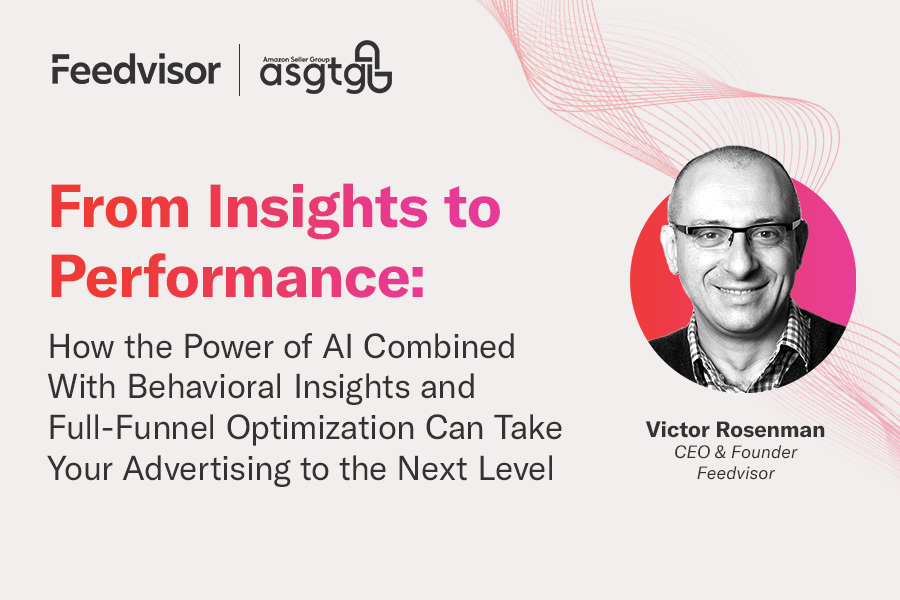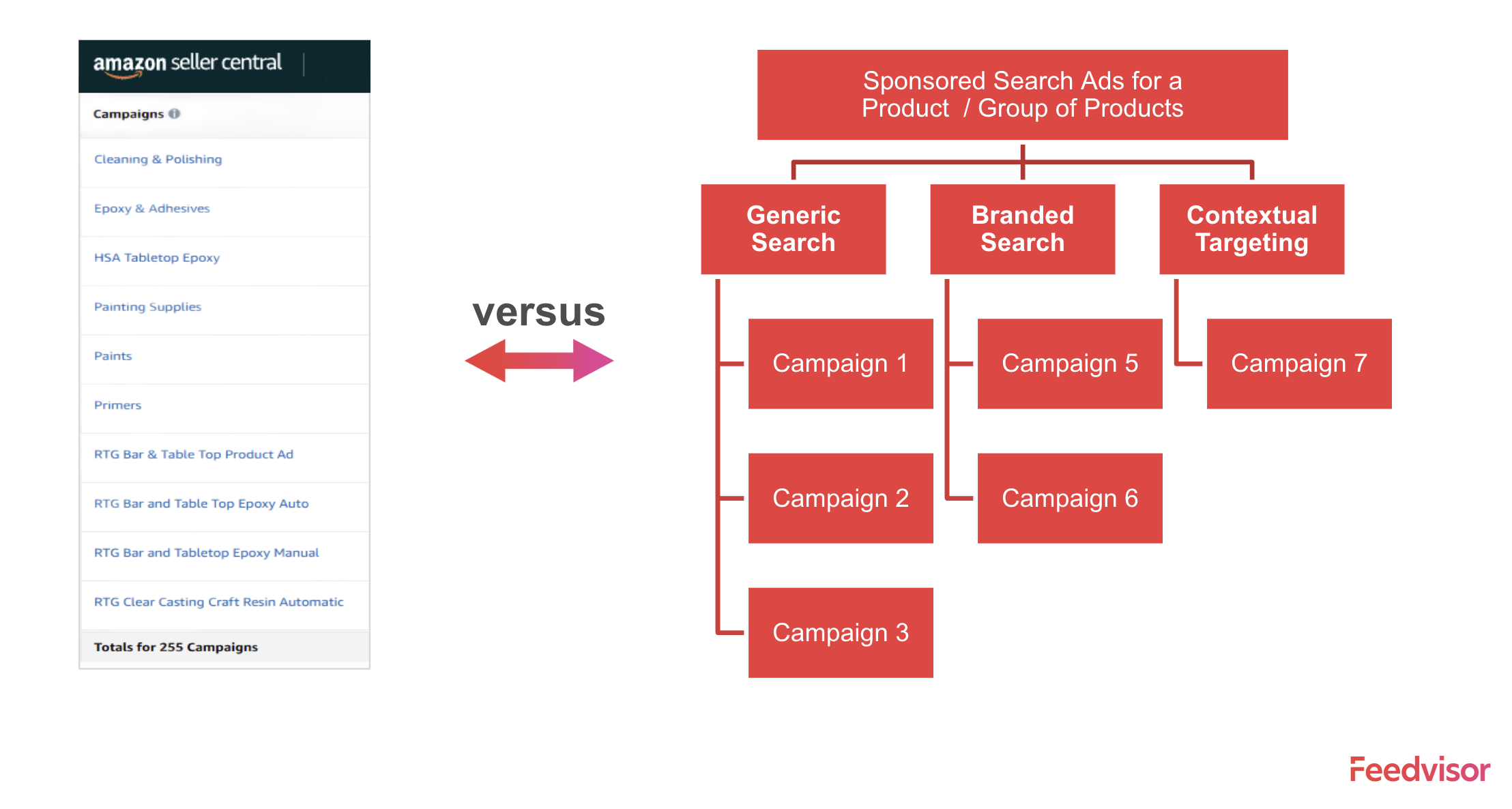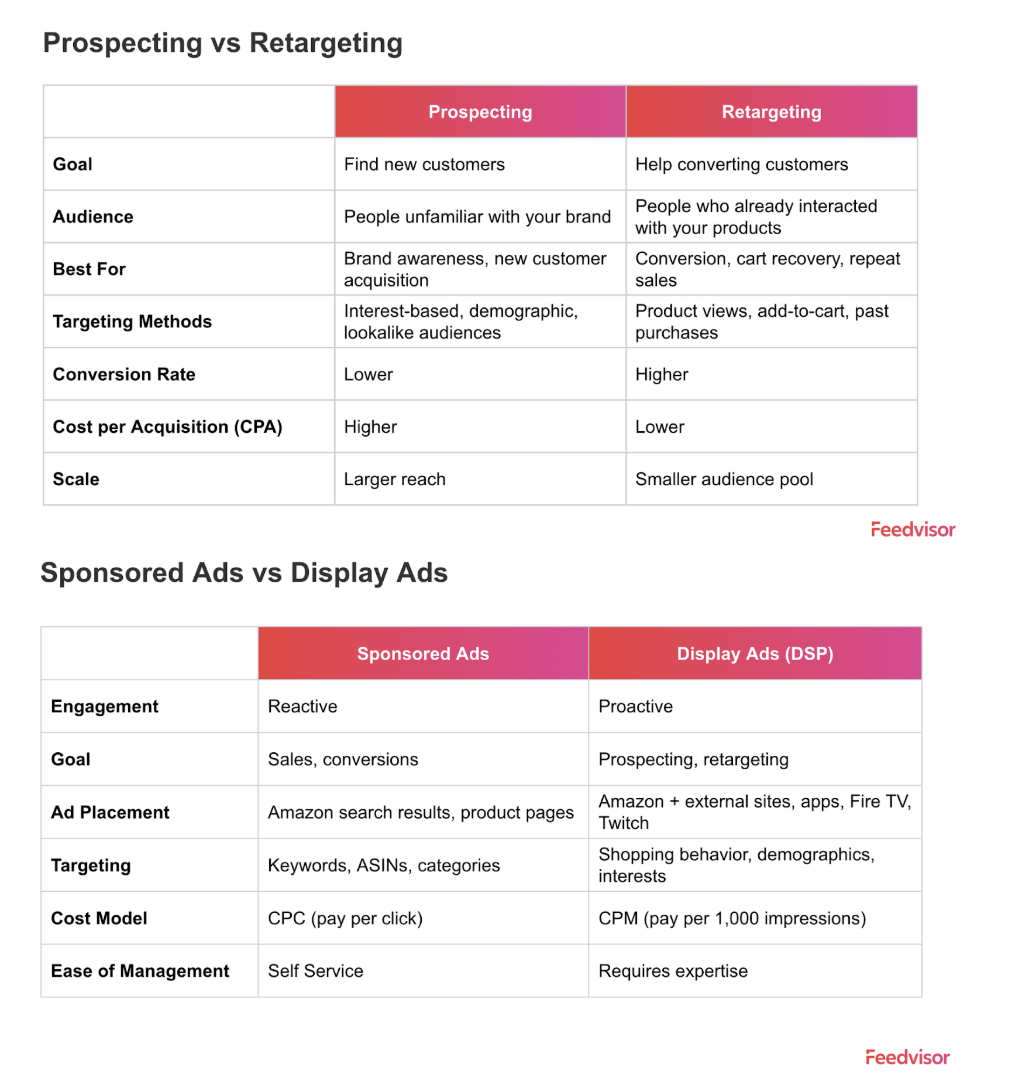Categories
Latest Posts
Tags
Advertising Amazon Amazon Advertising Amazon Experts Amazon Listing Optimization Amazon Marketplace Amazon News Amazon Prime Amazon Professional Sellers Summit Amazon Seller amazon sellers Amazon Seller Tips Amazon Seller Tools ASIN Brand Management Brands Buy Box Campaign Manager Conference COVID-19 downloadable Dynamic Pricing Ecommerce FBA FBM Holiday Season industry news Multi-Channel Fulfillment Optimize pay-per-click Pricing Algorithm Pricing Software Private Label Profits Repricing Repricing Software Revenue Sales Seller Seller-Fulfilled Prime Seller Performance Metrics SEO SKU Sponsored Products Ads Strategy
Get the latest insights right in your inbox
Resource | Blog

Looking for Better Ad Performance? Here’s Why AI and Full-Funnel Optimization Are the Answer
SUMMARY
We recap Victor Rosenman’s, CEO and Founder of Feedvisor, latest presentation at ASGTG 2025—exploring how AI and full-funnel optimization across search, DSP, and AMC are reshaping Amazon advertising performance.

Rachel Horner
Rachel Horner serves as a Content Marketing Writer for Feedvisor. She has extensive experience in writing for diverse B2B brands, particularly in the tech industry, and is dedicated to fostering meaningful brand-audience connections.
It’s time to rethink your Amazon advertising strategy.
The linear customer journey is a thing of the past, and paid ads are no longer optional. But how can you adapt?
It’s all about AI-powered precision—aligning your ads with the right keywords, optimizing bids in real-time, and leveraging data to refine your targeting across all touchpoints. In this blog, we’ll show you how to leverage Sponsored Products, DSP, and AMC to capture every crucial moment in the customer journey, with insights pulled directly from Feedvisor CEO Victor Rosenman’s presentation at this year’s ASGTG conference.
Why Advertising on Amazon Feels Harder Than Ever
Think back to when selling on Amazon felt a little more straightforward—when organic visibility could fuel growth and advertising was optional, not essential. Fast-forward to today: if you’re a private label seller or managing a branded product, success on Amazon has become pay to play.
But here’s the catch: even with increased ad spend, many sellers are seeing growth stall. Retail media is set to be the main engine behind U.S. search ad spend growth, projected to account for more than one-third of the entire U.S. search advertising market by 2027. Yet, the strategies that once drove consistent results aren’t delivering at the same pace anymore. Why?
The answer lies in a perfect storm of challenges: rising competition—especially from Chinese sellers—soaring CPCs, and shrinking margins. In 2024, China-based sellers surpassed the 50% mark in market share on Amazon. And that’s before you factor in competitors undercutting you, or resellers hijacking your listings and driving pricing chaos.
With all these complexities—rising competition, shifting costs, and the need to continuously adapt—advertising on Amazon isn’t as simple as it used to be. But understanding how to navigate these challenges requires more than just throwing more money at your campaigns. Success hinges on leveraging every stage of the funnel—from DSP to search—by tapping into behavioral insights and AMC data, optimized through the power of AI.
Step One: Optimizing Search Advertising
The Key to Success Starts with Strategy
It all starts with a well-structured search advertising strategy. Instead of blindly grouping all your keywords together and hoping for the best, it’s crucial to recognize that not all keywords are equal, and each requires its own approach. By understanding the different types of search terms and how they perform, you can create a more focused, efficient advertising strategy—one that stands up to the ever-evolving Amazon landscape.
Branded terms, organic search terms, long-tail keywords, short-tail keywords—each one behaves differently. By lumping them all together in the same campaign, you’re bidding against vastly different kinds of traffic.
So how do you set your ACoS (Advertising Cost of Sale) target to hit the mark? The most common method is to target a specific ACoS.
But here’s where the issue arises: you can’t set a unified ACoS target when your campaigns are a mix of vastly different keyword types. You can’t target at the keyword level—it’s too granular. And you can’t do it at the campaign level either, because you’re dealing with a bunch of keywords that behave in completely different ways.
The solution? Organize your campaigns around strategies.
Note: At Feedvisor, we define strategies as the core type of advertising you’ll be running, based on keyword behavior. It’s the first step toward creating targeted campaigns that deliver on your goals.

For example, you can create strategies for generic search, branded search, and others, each with its own dedicated campaigns and targets. This way, the targets within each campaign share similar characteristics, making it easier to set ACoS targets and budgets that align with your strategy.
By organizing your campaigns this way, you can match your goals to the specific behavior of your keywords, improving your advertising efficiency and performance.

Maximize Your Advertising Potential
Supercharge Your DSP Campaign Performance with Feedvisor360
Keyword Selection
Once your campaigns are organized by strategy, it’s time to define the keywords. There are three main use cases:
- New Product: If you’re launching a new product and don’t know the keywords, start with an automatic campaign, then transfer the best-performing keywords to a manual campaign. This approach works well for discovering the right terms.
- Existing Product: For a product that’s been around for a while, you likely already know your keywords, or you can use AI to generate them for you.
- Mature Product: For mature products with enough search history, you can use Amazon’s Search Query Performance to access detailed keyword data, both organic and paid.
By combining these three methods, you can effectively identify all the relevant keywords.
Setting Objectives and Budget Allocation
Once your campaigns and keywords are set, the next step is defining your objective. Do you want to maximize sales, hit a specific ACoS (e.g., 15-20%), or stay within a budget? This goal drives how you allocate resources across different strategies: branded search, generic search, and conquesting.
Each strategy requires different ACoS targets—branded search needs a lower ACoS due to higher conversions, while conquesting typically demands a higher ACoS. Short-tail keywords bring high traffic but are expensive, while long-tail keywords are cost-effective but generate less volume. A balance of both is key.
AI plays a critical role here, especially in optimizing bids. Feedvisor’s AI-powered algorithms analyze key metrics like keyword volume, conversion rates, and click-through rates to estimate each keyword’s potential and cost—determining the optimal mix that maximizes sales within budget while staying under your ACoS target.
The real challenge comes with budget allocation. Some sellers focus on controlling ACoS, while others focus on TACOS (Total Advertising Cost of Sales). Branded search can lower ACoS but may cannibalize organic search, increasing TACOS without boosting overall sales.
This is where optimization comes into play. In the scenario above, consider reducing your budget for branded search to protect your brand without overspending. Understanding what you’re optimizing for will guide smarter budget decisions and maximize efficiency.
Step Two: Investing in Display Ads
Display ads are simpler than they seem. Search ads are reactive—your ad appears when someone searches for your product. But if you want to reach customers proactively, DSP and Sponsored Display ads are the way to go.
At a high level, you can think of the differences as follows:

The key to knowing which technique to prioritize isn’t guesswork—it’s analyzing your customer journey and post-purchase data. Understanding how your audience interacts with your product will help you make smarter decisions about when to use prospecting or retargeting to optimize your display ad strategy.
Step Three: Leveraging AMC
Amazon Marketing Cloud (AMC) offers critical insights into how customers interact with your ads, allowing you to track their journey after viewing search ads, branded searches, or prospecting efforts. By combining this data with your advertising strategies, you can evaluate how effective your retargeting efforts are and refine your campaigns for better performance.
One key metric to watch is the “user purchase rate,” which shows how ad interactions influence purchasing behavior. For example, adding retargeting with contextual targeting boosted the purchase rate by 20 times—from 0.18% to 4%. Contextual targeting focuses on re-engaging customers who viewed your product but then considered a competitor’s. By showing your ad next to theirs, you increase the likelihood of conversion.
This illustrates the power of combining DSP with strategic retargeting. The most successful advertisers optimize their approach across the entire funnel—tracking every stage of the customer journey, not just the search and purchase moments. DSP lets you take proactive control, rather than simply reacting to customer actions as with search ads. Failing to leverage these strategies can leave you trailing behind the competition.
By tapping into AMC insights, you can refine your approach, target the right audience, and ultimately drive more conversions.
By combining search, DSP, and AMC, you create a powerful optimization triangle. Here’s how each element plays a role:
- Search provides high volume and captures immediate interest.
- DSP offers strategic targeting, including prospecting and retargeting, to reach customers at various stages of the buying journey.
- AMC gives you clear insights into customer behavior, allowing you to measure and refine your efforts.
When used together, these tools enable full funnel optimization, allowing you to strategically guide customers from awareness to conversion, and maximize your advertising impact.
Final Thoughts
To truly thrive on Amazon, you need precision, intelligence, and a holistic strategy. That’s where Feedvisor comes in. Our AI-powered advertising optimization takes the guesswork out of DSP campaigns and AMC analysis. With our data-driven technology and expert team, we’ll help you strategically plan, implement, and refine your campaigns—maximizing conversions and exceeding your goals every step of the way.
Ready for a new, holistic approach to your ad strategy, powered by AI? Start your 14-day free trial today.
You may also like
Get the latest insights right in your inbox
Thank you for signing up for our emails. You will receive a confirmation shortly.